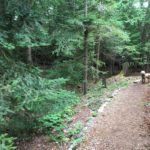We discovered that our new cottage property has several poison ivy patches. One of these patches is very large, at least 15-25 feet side, and spans a wet, shady area between our cottage and our neighbour’s abandoned Cottage’s driveway. It is located in the Kawarthas on Four Mile lake. While I can tend to the other, smaller, areas of poison ivy, this larger field/valley area is close to our house and is a concern. Just twice this week our dog ran through it after he got off leash, and we had to wash him twice before he could go close to our young children (ages 1 and 3). Using RoundUp on such a large area is going to be a problem not only for the environment but also due to its sheer size. Alongside the poison ivy are several ferns and trees. It is very damp, has fertile dark soil, and it is quite dark. Ideally I would like to plant something fern/bush like which will choke out the poison ivy.
Poison Ivy (Toxicodendron radicans) is common throughout Ontario and is an unwelcome plant everywhere it is found. It is extremely difficult to eradicate completely.
As you are already aware, all parts of the plant contain a volatile sap or oil, urushiol, that can cause mild to serious skin irritations, even with indirect contact (such as brushing against your dog). Even contact with the smoke from burning poison ivy is hazardous, which is why extreme caution is advised if you are considering burning poison ivy leaves.
Removing a large patch of poison ivy will take time and effort. It would be desirable for the poison ivy to be eradicated as much as possible before you consider planting anything to replace it. You should exercise great caution in pulling the plants, if this is what you decide to do: be aware that poison ivy reproduces rhizomatically (from any piece of root left in the ground) and be sure to thoroughly clean gloves, tools, etc. The Ontario Ministry of Agriculture and Rural Affairs (OMAFRA) website gives some useful advice on methods of control: https://www.omafra.gov.on.ca/english/crops/facts/99-015.htm. As you’ve noted OMAFRA permits the use of certain herbicides for poison ivy, glysophate (which is the active ingredient in RoundUp) being one of them. With this large patch, you may feel that a professional weed control company might be the best route to take. Your county office may be able to help with suggestions of local companies that specialize in noxious weed control.
In attempting to plant ferns or shrubs amongst a stand of poison ivy you will run the risk of coming into contact with it. There doesn’t appear to be any research on plants that are effective in choking it out. Sheep and goats are able to eat it without apparent ill effect but this may not be a practical solution in your part of Kawartha cottage country! When you are in a position to plant, you may be interested in Peterborough’s Green-Up Association, a community association dedicated to local environmental issues including the planting of native species: https://www.greenup.on.ca/ .
This website https://www.wildflower.org/expert/show.php?id=3819 provides detailed information on pulling up poison ivy plants, perhaps useful for the smaller areas of infestation on your property, and describes how to protect your skin. You’ll see that it is an American post from North Carolina, so although its planting suggestions are not appropriate for the Kawarthas, it may give you some ideas on the process of choosing appropriate native plants to replace your poison ivy.
You may be familiar with solarization, which is a nonchemical method for controlling weeds (and other soil borne pests) using high heat from the sun. Basically, weeds are killed by covering clean soil with clear plastic for several weeks during the heat of summer when the soil receives the most direct sunlight. This technique works best on shallowly rooted or annual weeds, but may be an option for the smaller areas in which you have poison ivy, if they receive more direct sunlight than your large patch, if you are able to pull the plants out, leaving a bare plot of soil, and if you are willing to repeat this process as needed.
While you are considering your approaches, you might think of using some inexpensive steel wire folding fencing, readily available at building centres, to temporarily cordon off that section of your property – it isn’t the strongest fencing, but it may provide enough of a deterrent to keep your dog out of the poison ivy.
On a slightly lighter note, interestingly, poison ivy belongs to the same plant family, Anacardiaceae, as mangos and cashews, and both these plants also produce urushiol. People who eat mango skins can get a rash on their lips, which is why we peel mangos before eating them.
Very best of luck with this problem – you are not alone!


